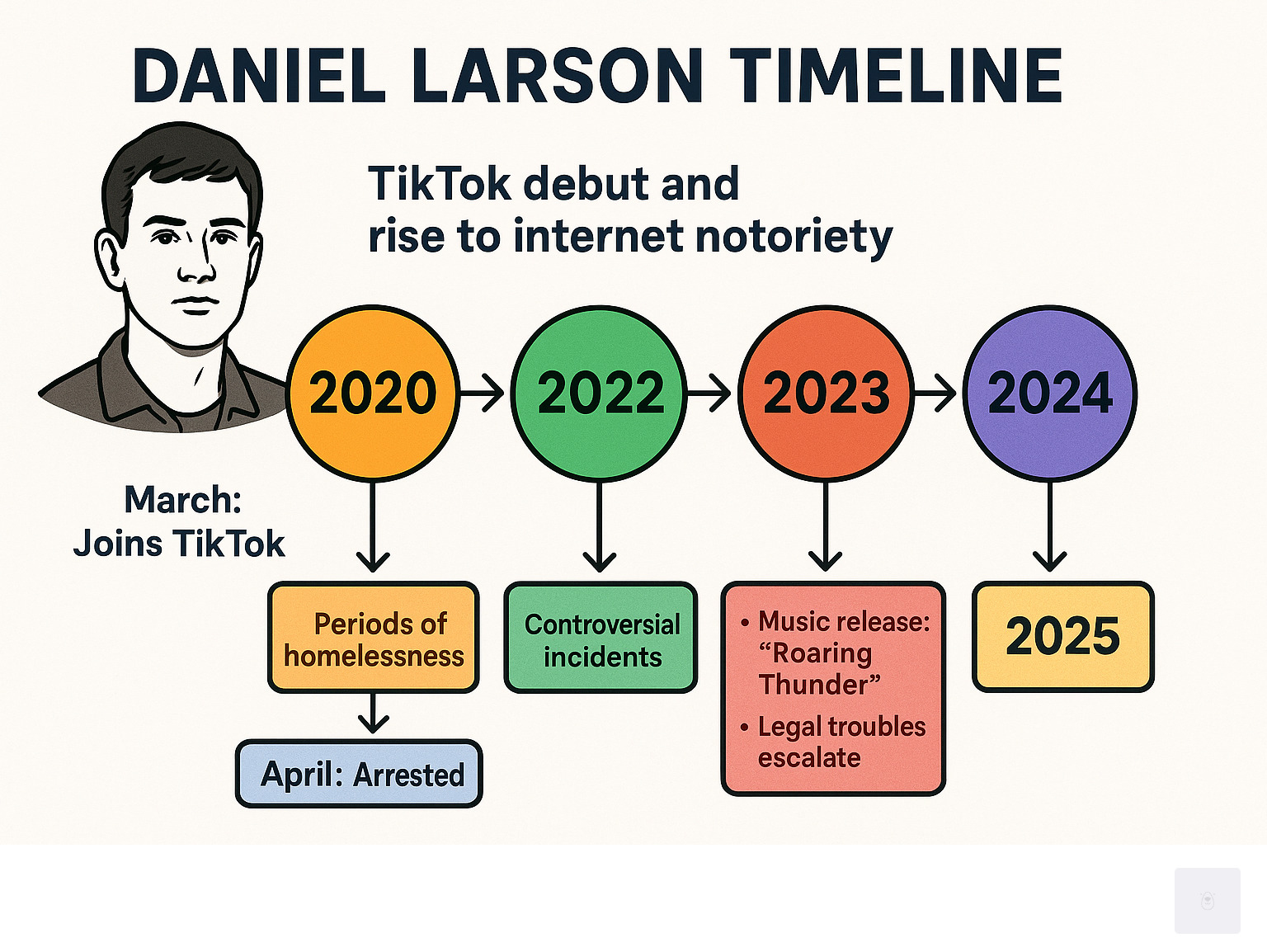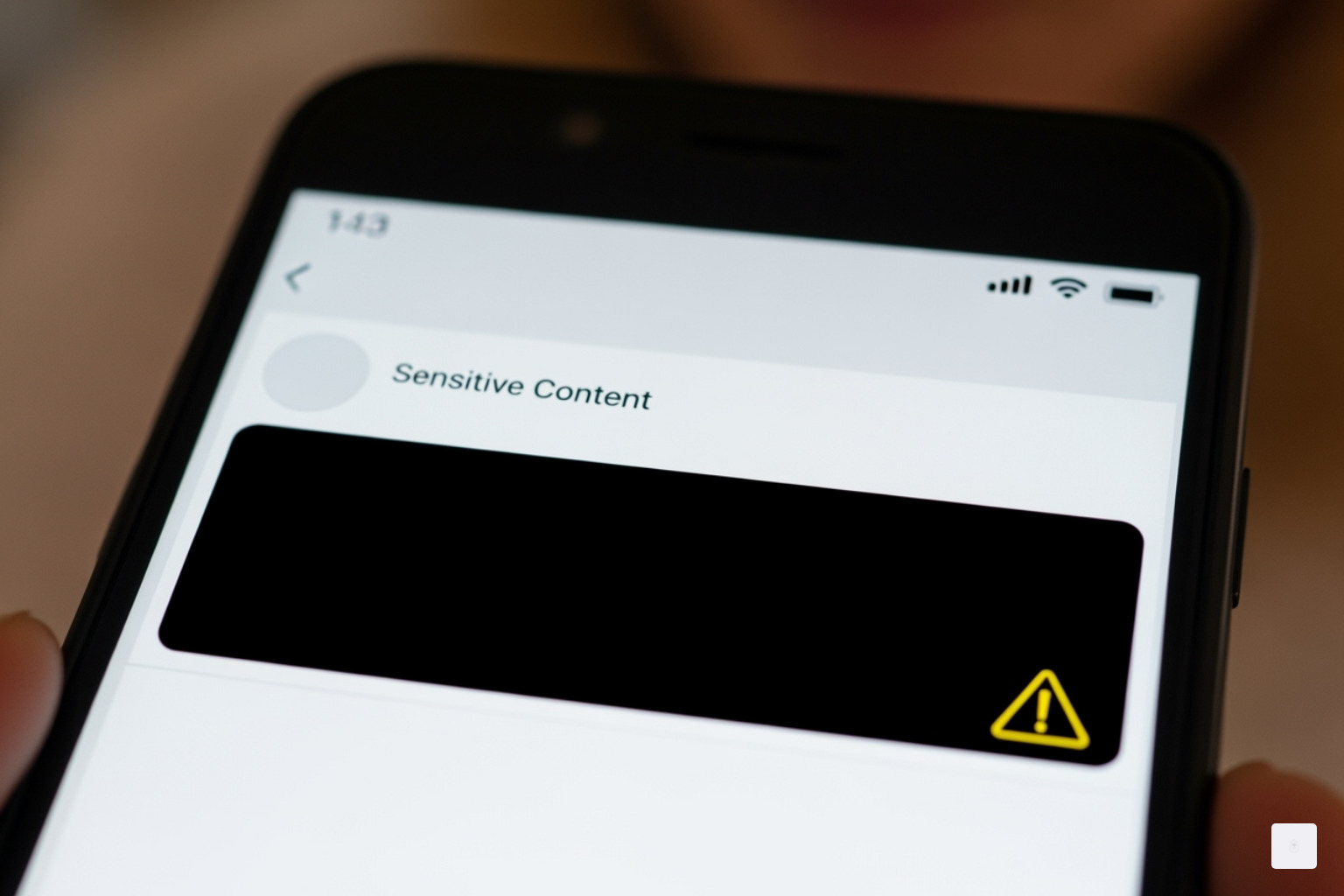
The Rise and Fall of a Digital Age Phenomenon

Daniel Larson represents one of the most disturbing examples of how internet fame can exploit vulnerable individuals with severe mental health issues. This American singer-songwriter and internet personality gained notoriety through TikTok starting in 2020, but his story quickly devolved into a tragic spectacle of homelessness, controversial behavior, and legal troubles.
Quick Facts About Daniel Larson:
- Born: November 15, 1998
- Famous For: Chaotic TikTok content and “outsider” music
- Mental Health: Diagnosed with Autism, ADHD, and Bipolar disorder
- Music: “Roaring Thunder” has nearly 1 million Spotify streams
- Legal Status: Arrested April 2, 2024; facing up to 65 years in prison
- Current Location: Federal medical facility undergoing mental health evaluation
The story of Daniel Larson unfolds as a uniquely modern tragedy – a case study in how social media can amplify mental illness for public consumption. His journey from troubled youth to internet notoriety illustrates the dark side of digital fame, particularly when vulnerable individuals become unwitting entertainment for online audiences.
His rise began innocently enough. In March 2020, Larson created his TikTok account “@daniellarsonfans” and started posting videos of his neighborhood. But what started as simple content creation quickly spiraled into a public documentation of severe mental health crises, homelessness lasting 796 days, and increasingly disturbing behavior that culminated in his arrest on serious federal charges.
The Daniel Larson phenomenon has been dissected extensively in cultural commentary circles, including discussions among New York City’s media elite who recognize his story as emblematic of larger societal issues around mental health, internet exploitation, and the responsibility of platforms.
As R. Couri Hay, having spent decades observing how public figures steer fame and crisis, I’ve seen how quickly celebrity can turn destructive – but rarely with such tragic consequences as in Daniel Larson’s case. His story serves as a stark reminder of the human cost of viral fame when it intersects with untreated mental illness.

Quick look at daniel larson:
The Origins of Daniel Larson: From Troubled Youth to TikTok Notoriety
Born on November 15, 1998, Daniel Larson’s journey to internet infamy was shaped by a profoundly challenging childhood. Reports indicate he experienced parental abuse and spent time in foster care and mental health institutions.
Without stable support systems, Daniel’s early trauma left deep wounds. It’s a story seen too often here in New York City, where vulnerable individuals fall through the cracks of systems meant to protect them. From a young age, he was diagnosed with Autism Spectrum Disorder, ADHD, and Bipolar disorder, conditions that profoundly affected his emotions and interactions.
His time in special needs education and various care facilities highlighted a need for consistent support that was often absent. This lack of a stable foundation became tragically apparent when his struggles played out publicly online.
The Rise to Fame on Social Media
Everything changed on March 30, 2020, with his TikTok account @daniellarsonfans. His unique perspective and uninhibited self-expression attracted viewers, quickly evolving from innocent content into a raw, unscripted reality show of his erratic behavior that millions found compelling.
Daniel became an unwitting celebrity almost overnight. His online persona was a chaotic mix of vulnerability and delusions that fascinated and disturbed viewers. As his following grew on YouTube and other platforms, he attracted a strange mix of genuine fans, exploitative trolls, and self-proclaimed “caretakers” who often made things worse.
This dynamic perfectly illustrates how social media can transform personal struggles into public spectacle. For insights into how these platforms can be better managed, you might find our social media services perspective helpful.
Troublingly, his fan interaction often encouraged his most concerning behaviors. The more outrageous his content, the more attention he received, creating a dangerous feedback loop that contributed to his downfall.
Background and Mental Health
Understanding Daniel Larson requires acknowledging how his mental health shaped his online presence. His diagnoses of Autism, ADHD, and Bipolar disorder explain much of his behavior, from social difficulties to impulsivity and extreme mood swings.
His childhood trauma worsened these challenges. Without proper treatment, his conditions went unmanaged, leading to public meltdowns broadcast to his audience. His difficulty discerning truth from delusion became a defining characteristic, adding to the fascination and horror of his story.
The lack of a consistent support system meant his most vulnerable moments became entertainment. For a glimpse into his background, you can watch this Reddit video of Daniel talking about his backstory, though his narrative is often colored by his conditions. His case highlights the urgent need for better support systems for vulnerable individuals, a topic of growing importance in communities like New York City.
The “President’s” Music Career and Delusional Narrative
Daniel Larson‘s venture into music encapsulates the blurred lines between reality and delusion that define his persona. His output is classic “outsider music”—raw, unpolished recordings that blend artistic expression with symptoms of severe mental illness.
His most successful track, “Roaring Thunder,” has nearly one million Spotify streams, a surprising achievement given his chaotic online fame. His discography also includes titles like “Something More” (2022) and “Banned From Detroit” (2024). However, controversy shadows his musical achievements, with persistent rumors that he didn’t write “Roaring Thunder” or other singles. This raises uncomfortable questions about authorship and exploitation. In New York City’s celebrity circles, authenticity debates are common, but rarely involve someone so vulnerable.
His musical journey adds another layer to the ethical questions surrounding his fame. You can explore his discography on Daniel Larson’s Spotify Profile. For those interested in how unconventional personalities build a brand, our insights on Explore our branding services offer a contrast to Daniel’s chaotic approach.
Notable Songs and Musical Style
Daniel Larson‘s musical catalog is highly unpredictable. While “Roaring Thunder” is a polished track, much of his work consists of raw, acapella phone recordings captured during chaotic moments. These raw recordings offer an unsettling window into his mental state. They are less like songs and more like audio diaries of his psychological struggles, featuring off-key singing and rambling lyrics reflecting his delusions. The contrast with his professional tracks is jarring.
His lyrical themes mirror his real-life obsessions, from grandiose declarations to narratives about perceived enemies. Some tracks are fan-produced, adding another layer of complexity to what constitutes “his” music versus what others created around his persona.
Delusions and The Role of Lies
The defining characteristic of Larson’s narrative is his profound struggle with delusions and fabricated stories. This is a direct symptom of his mental health conditions, including diagnosed autism, ADHD, and bipolar disorder, compounded by suspected schizophrenia.
His false narratives are elaborate, frequently claiming celebrity status, wealth, and romantic relationships with famous figures like singer Grace VanderWaal. These delusions, which he presents as truth, have led to concerning behavior and legal troubles. Understanding his story requires navigating a constant stream of contradictory statements and fabrications. As accounts of his life note, “most of what is said by Daniel himself is not always true.” From our perspective in New York’s media landscape, his lies aren’t strategic; they’re symptomatic of a tragic public health crisis.
Controversy and Crisis: The Dark Side of Internet Fame
Daniel Larson’s rise on social media came at a devastating cost. His content quickly spiraled from quirky videos into a public documentation of mental health crises, disturbing behavior, and legal concerns that led to his downfall.
His online presence became a breeding ground for controversy, with regular public meltdowns and the use of racial slurs. Most troubling were the paedophilia allegations that emerged. Larson initially admitted to concerning actions but later retracted his statements, a typical pattern. The situation escalated when his leaked Pinterest account and search history revealed unsettling content, fueling public outrage.
The constant scrutiny and manipulation from “trolls” and “caretakers” created a toxic environment that amplified his worst behaviors. As an observer of how public figures handle crises in New York City, I see Daniel Larson‘s situation as a tragic example of internet fame exploiting the vulnerable.

The Health and Homelessness Crisis of Daniel Larson
Larson’s physical reality was as disturbing as his online controversies. He was homeless for 796 days, a period that devastated his health. His mental conditions made stable housing impossible, leading to evictions for property damage and erratic behavior.
On the streets, his health deteriorated. He developed scabies, trench foot, and a serious toe infection, all documented in his videos. He became a public health hazard, with communities like Anaheim, California, issuing warnings to residents. His homelessness became content, turning his suffering into a spectacle.
Understanding the Controversies Surrounding Daniel Larson
The controversies surrounding Larson are inseparable from his severe mental illness and the exploitative online ecosystem. His inappropriate communications and use of slurs, while inexcusable, must be viewed in the context of his untreated conditions and toxic environment.
The paedophilia allegations are particularly troubling due to his pattern of admitting and then retracting guilt, a trait tied to his delusions. This uncertainty highlights the complex intersection of mental illness and accountability. Furthermore, online manipulators actively encouraged his harmful behaviors for content, creating a perfect storm of exploitation.
The Daniel Larson phenomenon is a cautionary tale about the responsibility of platforms and audiences. For those facing similar crises, our crisis management PR services offer guidance. His story forces a conversation about voyeurism and exploitation, one that resonates strongly in media-savvy hubs like New York City.
The Current Legal Status of Daniel Larson
Daniel Larson‘s internet fame came to an abrupt halt on April 2, 2024, with his federal arrest. After years of escalating behavior, law enforcement took decisive action that fundamentally changed his story.
The charges against him are serious, including making threats and evading police, and could lead to up to 65 years in federal prison. The case is complex due to the intersection of his severe mental health conditions and the legal system. Recognizing this, authorities placed him in the United States Medical Center for Federal Prisoners in Springfield, Missouri, for a four-month mental health evaluation.
For those of us who’ve watched celebrity legal dramas unfold in New York City, Daniel Larson‘s case represents a collision between untreated mental illness, internet exploitation, and federal criminal charges.
Arrest and Incarceration
Larson’s arrest was unsurprising to followers of his increasingly erratic behavior. Years of public meltdowns and disturbing incidents had escalated to a point authorities could no longer ignore. His arrest marked the end of 796 days of homelessness and the start of a new chapter.
The decision to place him in a specialized federal medical facility shows the justice system is acknowledging his mental health as a crucial factor in his case, rather than treating him simply as a criminal.
What the Future Holds
The current four-month mental health evaluation will likely determine his future. Its findings will influence whether he is deemed competent to stand trial or requires long-term psychiatric treatment instead of incarceration. If convicted, he could face decades behind bars.
Either way, this appears to mark the end of his chaotic online presence. His story forces us to grapple with how society handles vulnerable individuals who become internet spectacles. Here in New York City, his case stands out as particularly tragic, highlighting the urgent need for better mental health resources and platform responsibility. His journey from TikTok creator to federal prisoner is a stark reminder of the real people and struggles behind viral content.
Frequently Asked Questions about Daniel Larson
When discussing Daniel Larson in media circles here in New York City, certain questions come up repeatedly. His story is a troubling case study in modern celebrity culture and its darker implications.
What is Daniel Larson most famous for?
Daniel Larson is famous for his chaotic TikTok presence, which began in 2020. His notoriety stems from his unfiltered documentation of severe mental health struggles, his “outsider” music, and a public battle with homelessness. His raw, unedited videos showcased erratic behavior and delusional narratives, creating a disturbing form of entertainment that attracted millions. His music, especially the track “Roaring Thunder,” added to his fame, but his legacy is defined by the public broadcast of his vulnerable mental state and the ethical questions it raises.
What are Daniel Larson’s main mental health diagnoses?
Daniel Larson has been formally diagnosed with Autism Spectrum Disorder, Attention-Deficit/Hyperactivity Disorder (ADHD), and Bipolar disorder. These conditions explain his difficulties with social interaction, impulsivity, and dramatic mood swings. There is also widespread speculation about undiagnosed schizophrenia due to his elaborate delusions. His childhood trauma and a lack of consistent mental health support likely compounded these conditions, leading to his public deterioration.
Is Daniel Larson currently in jail?
Yes, Daniel Larson is in federal custody following his arrest on April 2, 2024. He is not in a typical jail but is undergoing a four-month mental health evaluation at a federal medical facility in Springfield, Missouri. He faces serious charges, including making threats and evading police, with a potential sentence of up to 65 years. The evaluation’s outcome will determine if he stands trial or is placed in long-term psychiatric care. As we often see in high-profile cases in New York, his situation represents a complex intersection of mental health, fame, and the justice system, likely marking the end of his online career.
Conclusion
The story of Daniel Larson serves as one of the most troubling examples of how our digital age can transform personal tragedy into public entertainment. What began as a young man’s struggle with severe mental health challenges became a viral spectacle that millions watched unfold in real time.
His journey from troubled youth to internet notoriety exposes the dark underbelly of social media fame. Daniel Larson‘s 796 days of homelessness, his deteriorating mental health, and his eventual arrest weren’t just personal struggles – they became content for an audience hungry for the next viral moment.
The human cost of this phenomenon cannot be ignored. Behind every bizarre video and controversial post was a person suffering from autism, ADHD, and bipolar disorder. His delusions and erratic behavior weren’t entertainment choices – they were symptoms of untreated mental illness playing out on a global stage.
As someone who has spent decades observing celebrity culture here in New York City, I’ve witnessed how fame can both lift and destroy. But Daniel Larson‘s case is uniquely disturbing because it highlights our collective failure to protect vulnerable individuals from exploitation.
His story forces uncomfortable questions about our digital society. What responsibility do platforms have when users clearly need help rather than followers? How do we balance free expression with protecting those who cannot protect themselves? When does watching become enabling?
The answers aren’t simple, but Daniel Larson‘s tragic trajectory from TikTok creator to federal prisoner reminds us that real people exist behind our screens. His current incarceration and mental health evaluation may finally provide the intervention he desperately needed – but it came at an enormous cost.
This complex cultural phenomenon demands more than our attention. It requires us to examine how we consume content, how we treat mental illness, and how we can build a more compassionate digital world. Daniel Larson‘s story is a cautionary tale that should inspire change, not just clicks.
Read more insider stories and cultural commentary on R. Couri Hay’s Columns

